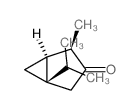Thujone inhibits lung metastasis induced by B16F-10 melanoma cells in C57BL/6 mice.
Kodappully S Siveen, Girija Kuttan
Index: Can. J. Physiol. Pharmacol. 89(10) , 691-703, (2011)
Full Text: HTML
Abstract
The antimetastatic potential of thujone, a naturally occurring monoterpene, was evaluated. Metastasis was induced in C57BL/6 mice by injecting highly metastatic B16F-10 melanoma cells through the lateral tail vein. Administration of thujone (1 mg·(kg body weight)(-1)), prophylactically and simultaneously with tumor induction, inhibited tumor nodule formation in the lungs by 59.45% and 57.54%, respectively, with an increase in the survival rate (33.67% and 32.16%) of the metastatic tumor bearing animals. These results correlated with biochemical parameters such as lung collagen hydroxyproline, hexosamine and uronic acid contents, serum sialic acid and γ-glutamyl transpeptidase levels, and histopathological analysis. Treatment with thujone downregulated the production of proinflammatory cytokines such as tumor necrosis factor-α, interleukin (IL)-1β, IL-6, and granulocyte-monocyte colony-stimulating factor. Thujone administration downregulated the expression of matrix metalloproteinase (MMP)-2, MMP-9, extracellular signal-regulated kinase (ERK)-1, ERK-2, and vascular endothelial growth factor (VEGF) and also upregulated the expression of nm-23, tissue inhibitor of metalloproteinase (TIMP)-1, and TIMP-2 in the lung tissue of metastasis-induced animals. Treatment with thujone inhibited the activity of MMP-2 and MMP-9 in gelatin zymographic analysis. Thujone treatment significantly inhibited the invasion of B16F-10 melanoma cells across the collagen matrix in a Boyden chamber. Thujone also inhibited the adhesion of tumor cells to collagen-coated microtire plate wells and the migration of B16F-10 melanoma cells across a polycarbonate filter in vitro. These results indicate that Thujone can inhibit the lung metastasis of B16F-10 cells through inhibition of tumor cell proliferation, adhesion, and invasion, as well as by regulating expression of MMPs, VEGF, ERK-1, ERK-2, TIMPs, nm23, and levels of proinflammatory cytokines and IL-2 in metastatic animals.
Related Compounds
| Structure | Name/CAS No. | Molecular Formula | Articles |
|---|---|---|---|
 |
α-Thujone
CAS:546-80-5 |
C10H16O |
|
Attempts to separate (-)-α-thujone, (+)-β-thujone epimers fr...
2013-03-01 [J. Sep. Sci. 36(5) , 832-9, (2013)] |
|
Long-term stability of thujone, fenchone, and pinocamphone i...
2009-04-08 [J. Agric. Food Chem. 57(7) , 2782-5, (2009)] |
|
Toxicokinetics of α-thujone following intravenous and gavage...
2013-09-01 [Toxicol. Appl. Pharmacol. 271(2) , 216-28, (2013)] |
|
Skeletal muscle fatty acid oxidation is not directly associa...
2011-06-01 [Appl. Physiol. Nutr. Metab. 36(3) , 361-7, (2011)] |
|
Metabolism of α-thujone in human hepatic preparations in vit...
2011-02-01 [Xenobiotica 41(2) , 101-11, (2011)] |